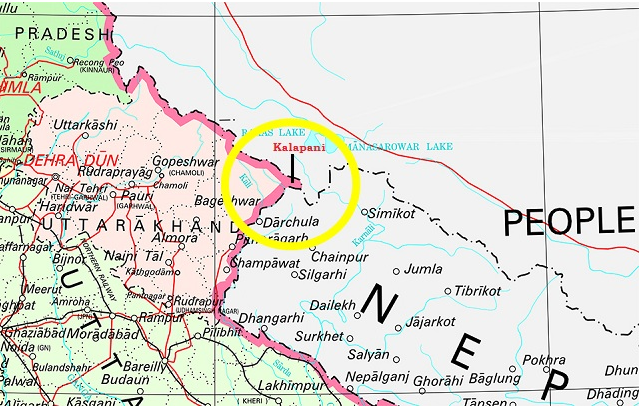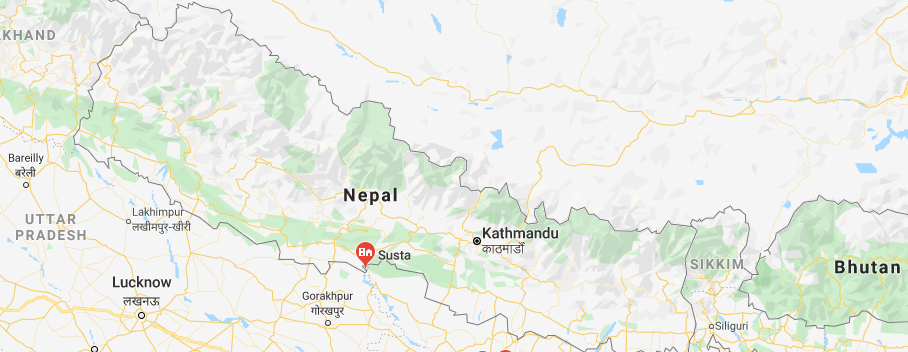International Relations
Indo-Nepal Territorial Dispute
- 29 Nov 2019
- 8 min read
This article is based on “A line runs through it” which was published in The Indian Express on 27/11/2019. It talks about various narratives of India-Nepal territorial dispute.
Recently, anti-India demonstrations were seen on the streets of Nepal over the release of a new political map of India, made after the bifurcation of the state of Jammu and Kashmir (J&K) into the Union Territories of J&K and Ladakh.
- The maps showed Kalapani (at the India-Nepal-China trijunction) to the north and Susta (bordering Bihar) to the south as Indian territory.
Reason for Anti-India Sentiments
Nepal and India have been bound together since ages through historical, religious, social, cultural, economic and political relations. The relationship is unique in a sense that neither country has allowed a political boundary to interrupt the free movement of people.
- Nepal is ruled by the Nepal Comunist Party (NCP) which has political leanings towards China.
- China is also actively pursuing its foriegn policy to decrease India’s influence over Nepal and mark its footprints in the territory of Nepal.
- A major rupture in relations between the two countries occurred in 2015 at the time of the making of the current constitution of Nepal (which replaced the 2007 Interim Constitution).
- India unsuccessfully tried to pursue Nepal to amicably address the grievances of the Madheshi, Janajati and other disadvantaged groups who constitute the bulk of the Nepalese population.
- Since then, misunderstandings, real or imaginary, persists between the two countries which have become an advantage to some third party players in Nepal like China.
- Also, triggering anti-India sentiments by communists or the pro-China political leadership has become the new normal in Nepal’s domestic politics. The nationalist sentiment has now become a potent instrument for political mobilisation.
Kalapani and Susta Dispute
The Kalapani territory has become a bone of contention between India and Nepal and the controversy has arisen due to the release of a new political map by India after bifurcation of Jammu and Kashmir.
- The Treaty of Sugauli concluded between British India and the Kingdom of Nepal in the year 1816, maps the Makhali river as the western boundary with India but different British maps showed the source of the tributary at different places which was mainly due to underdeveloped and less-defined surveying techniques used at that time.
- The discrepancy in locating the source of the river led to boundary disputes between India and Nepal, with each country producing maps supporting their own claims.
The Susta territorial dispute has arisen as a result of the shifting of the course of the Gandak river.
- The Treaty of Sagauli defined Gandak as the international boundary between India and Nepal.
- When the treaty was signed, Susta was on the right bank of the river Gandak which falls in Nepal territorial control. But, in due course of time, the river has changed its course and Susta now falls on the left bank of the Gandak, which is controlled by India.
Legal Dimension of Issue
According to International Laws, the principles of avulsion and accretion are applicable in determining the borders when a boundary river changes course.
- Avulsion: It is the pushing back of the shoreline by sudden, violent action of the elements, perceptible while in progress. Also it can be defined as the sudden and perceptible change in the land brought about by water, which may result in the addition or removal of land from a bank or shoreline.
- Accretion: It is the process of growth or enlargement by a gradual buildup. It is the natural, slow and gradual deposit of soil by the water.
If the change of the river course is rapid – by avulsion – the boundary does not change. But if the river changes course gradually – that is, by accretion – the boundary changes accordingly.
Since, the Gandak change of course has been gradual, India claimed Susta as part of their territory as per international laws.
- On several occasions, India has tried to resolve the issue through friendly and peaceful negotiations, but the Nepali leadership has always shown hesitation in resolving the issue.
- In Nepal, the issue has become a tool for arousing strong public sentiment against India. Therefore, resolving the issue may not be in the best interest of Nepal's domestic politics.
International Law on Trans-boundary Water Disputes
The Convention on the Protection and Use of Trans-boundary and International Lakes, also known as the Water Convention, is an international environmental agreement under United Nations Economic Commission of Europe (UNECE).
- It was signed in Helsinki (Poland) in 1992.
- The purpose of the Convention is to improve national attempts and measures for the protection and management of trans-boundary surface waters and groundwater.
- Under the convention, parties are obliged to cooperate and create joint bodies for parties bordering the same trans-boundary waters.
Way Forward
- India should maintain a policy of keeping away from the internal affairs of Nepal, while at the same time, in the spirit of friendship, India should guide the nation towards a more inclusive democracy.
- Since the free movement of people is permitted across the border, Nepal enjoys immense strategic relevance from India’s national security point of view, as terrorists often use Nepal to enter India.
- Therefore, stable and friendly relations with Nepal is one of pre-requisites which India can’t afford to overlook.
- India should also try to convey to Nepal’s leadership about the congenial and friendly environment that 6 to 8 million Nepali citizens living in India enjoys. Therefore, any thoughtless erosion of this centuries old togetherness may prove difficult for both countries.
The existing bilateral treaties between India and Nepal have not taken the shifting of Himalayan rivers into consideration. A primary reason for this is the lack of an approach where ecological concerns and needs of rivers are often dismissed.
- Therefore, India and Nepal should try to resolve the boundary dispute by taking into account all shared environmental characteristics.
| Drishti Input: Highlight the dynamics of India-Nepal relationship with a special focus on border disputes. |






